What is UN Security Council 1701?published at 08:48 Greenwich Mean Time
A little earlier we reported on the Lebanese government saying it is committed to implementing a UN Security Council resolution that ended the 2006 Israeli-Hezbollah war.
The ceasefire deal that came into effect overnight closely resembles the terms of that previous agreement, formally known as UN Security Council resolution 1701.
The resolution effectively aims to create a buffer zone in southern Lebanon between Israeli and Hezbollah forces, with Lebanese and UN forces occupying the area.
So under the resolution, areas south of the Litani river should be free of any armed personnel or weapons other than those of the Lebanese state and the UN peacekeeping force (Unifil).
Both sides have repeatedly claimed violations of the resolution in the past.
Under the new ceasefire agreement, the US and France will join the existing tripartite mechanism, involving Unifil, Lebanon and Israel, and is charged with monitoring violations, according to a UN official.
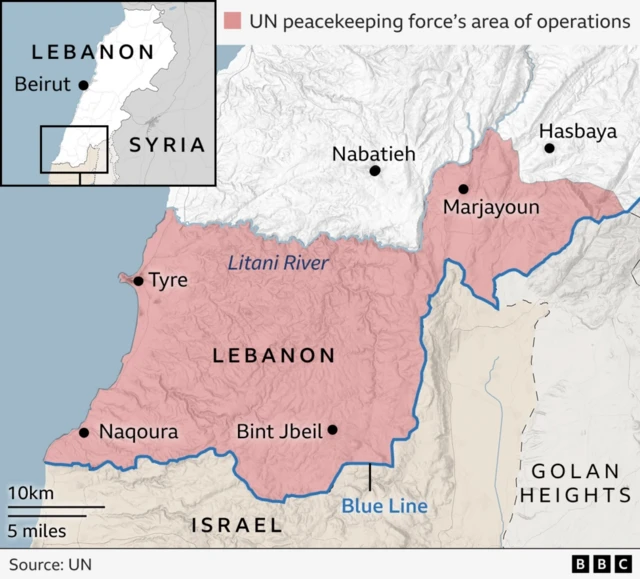

Gaza conflict will be harder to solve than Lebanonpublished at 08:30 Greenwich Mean Time
Frank Gardner
Security correspondent in Jerusalem
In the dying days of the Biden presidency, this is supposed to be a big foreign policy achievement in the Middle East.
I think the region will be breathing a sigh of relief that at least one fire is being extinguished. Attention will now turn to Gaza, which is the main conflict in the region, and probably a harder one to solve.
The difference being that in Lebanon, the deal involves a government, whereas in Gaza, Hamas is proscribed by many governments in the West as a terrorist group, and Israel vowed to destroy it altogether after the attacks of 7 October last year. So that’s going to be much tougher to do.
There is also the complicating factor of around 100 Israeli hostages still being held, presumably in tunnels beneath Gaza.
On balance, Tuesday was a good day for the Middle East. But over the next 60 days, people are going to be watching to see if the Israel-Lebanon peace deal actually holds.
Ceasefire deal ‘a big relief’, former Lebanese diplomat sayspublished at 08:15 Greenwich Mean Time
We’re now hearing reactions to the ceasefire agreement from former diplomats.
Tracy Chamoun, a former Lebanese ambassador to Jordan, says the deal comes as “a big relief to everybody, and especially those who have been displaced,” and describes the moments before the agreement came into effect.
“Last night was one of the worst nights of bombing that we’ve had, as the Israelis tried to target as many sites as they could within the time frame remaining from them. There were about 40 strikes alone on the city of Baalbek, and Beirut was hit very very hard yesterday,” she says in a BBC interview.
Gina Abercrombie-Winstanley, who is president of the Middle East Policy Council and a former US ambassador, says she is hopeful the ceasefire deal will hold.
The “IDF had unprecedented success with weakening Hezbollah”, she says. That began with the targeting Hezbollah’s pagers with explosives, and continued through attacks and assassinations of the group’s senior leadership.
Then, “the ground invasion and overwhelming air power that devastated Hezbollah fighters in southern Lebanon and wreaked great havoc and destruction in Lebanon itself,” Abercrombie-Winstanley tells BBC’s 5 Live Breakfast programme.
“Both sides were feeling the strain of the active combat.”
IDF says it fired at vehicle in ‘zone prohibited for movement’ in Lebanonpublished at 07:59 Greenwich Mean Time
The Israel Defense Forces has released a statement saying that in the last hour it fired on a vehicle “with several suspects” that was travelling “in a zone prohibited for movement in Lebanese territory”.
“The forces fired to prevent their arrival in the area, and the suspects moved away,” it says.
In the statement, the IDF says it has been operating in accordance with the ceasefire agreement and “will operate against anyone who attempts to breach the … agreement”.
When the deal was first announced, Israeli Prime Minister Benjamin Netanyahu said his country would not hesitate to strike if Hezbollah breaks the terms.
The IDF statement says Israeli forces are “stationed at their positions in southern Lebanon” and that the air force “remains ready to act across Lebanese territory”.
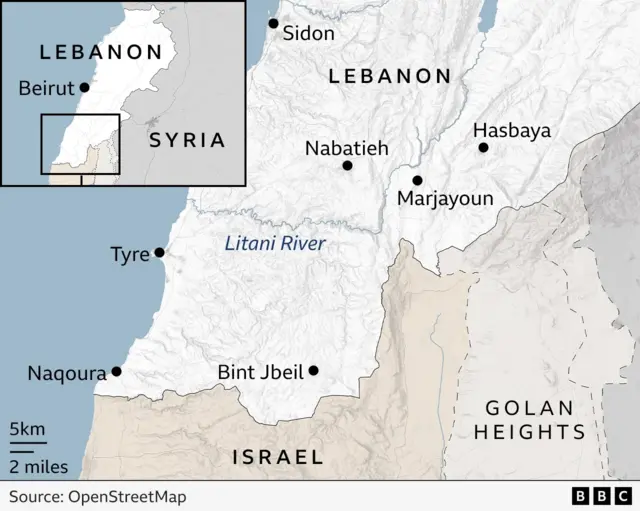
Lebanese minister says more troops will be deployed southpublished at 07:51 Greenwich Mean Time
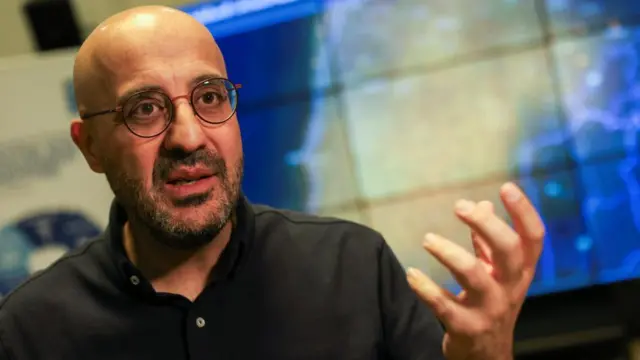 Image source, Reuters
Image source, Reuters
Lebanon’s environment minister and the co-ordinator of the government’s emergency response to the war, Nasser Yassin, has just been speaking to BBC Radio 4’s Today programme.
He says the country is committed to implementing UN Security Council Resolution 1701, which ended the 2006 war between Israel and Hezbollah and included measures to keep Hezbollah away from the Israeli border.
It’s put to him that the terms of that resolution have not been met, and Yassin is asked if Lebanon and the UN will be able to stop Hezbollah from regrouping and attacking Israel.
He says that Lebanon is committed to implementing the agreement, which includes a measure to deploy Lebanese forces to the country’s south.
He says that the country’s army is “going to increase the number of soldiers and officers” to be “the authority of the Lebanese state in that area”.
Yassin says Israel also must respect the resolution.
Excitement palpable on main highway to southern Lebanonpublished at 07:37 Greenwich Mean Time
Hugo Bachega
Middle East correspondent
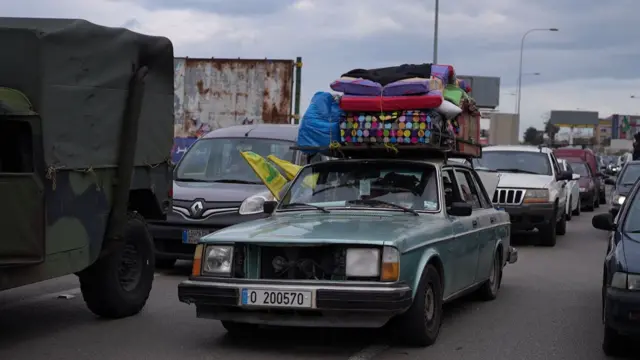
We are on our way to southern Lebanon, an area where there is strong support for Hezbollah, as thousands of people have started to return to their homes, hours after a ceasefire between Israel and Hezbollah came into effect.
There are traffic jams on the main highway between Beirut and the south, and cars are packed with families, bags, suitcases and mattresses. We have spotted many Hezbollah flags being waved in the windows.
Some people, when they see our camera, smile and make the “V” sign of victory. This return happens as Israeli and Lebanese authorities have warned people not to go back now.
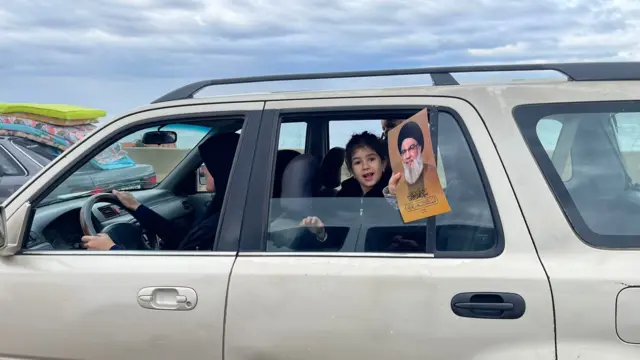
Israeli forces are still in parts of the south, as their withdrawal is expected to be gradual during the 60-day ceasefire.
The Lebanese military, expected to boost its presence in the south with 5,000 additional soldiers, said it was taking the “necessary measures” to complete its deployment.
Pictures show residents of southern Lebanon returning homepublished at 07:26 Greenwich Mean Time
People displaced from southern Lebanon are returning home following a ceasefire agreement between Israel and Hezbollah.
The IDF has warned residents to avoid moving south yet – but many in Lebanon have headed for their homes.
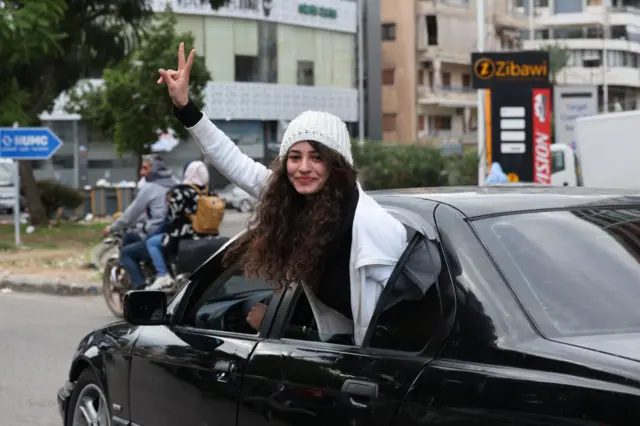 Image source, Getty Images
Image source, Getty Images
Displaced Lebanese people are returning to the country’s south following the agreement
 Image source, Reuters
Image source, Reuters
Many homes have been destroyed in the conflict between Israel and Hezbollah. Here we can see two children walking past what used to be their house in the city of Tyre
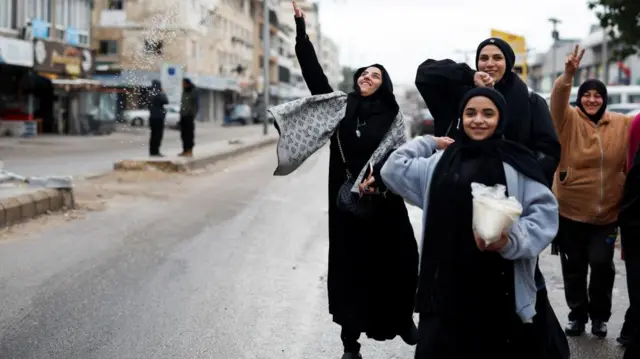 Image source, Reuters
Image source, Reuters
A group of women welcome people coming back to the city of Tyre in southern Lebanon
Some Israelis are angry about the ceasefire dealpublished at 07:19 Greenwich Mean Time
Lucy Williamson
Reporting from Jerusalem
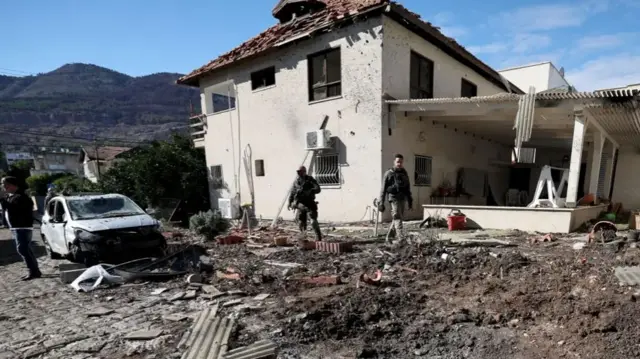 Image source, EPA
Image source, EPA
People are afraid to return to their homes in northern Israel
One poll yesterday suggested that more than 80% of Netanyahu’s support base opposed a ceasefire deal, and residents in the north of Israel – large numbers of whom have been evacuated from their homes – are angry too.
Nationally, the picture was more split, however. One poll showed 37% of Israelis in favour of the ceasefire, 32% against and 31% saying they didn’t know.
Shelly, an English teacher in Shlomi, said a ceasefire was an “irresponsible and hasty political decision”.
Rona Valency, evacuated from kibbutz Kfar Giladi on 8 October last year, told me she wanted to go home, and that a ceasefire was needed, but that the idea of Lebanese residents returning to these border villages gave her “a real sense of unease and fright”.
“The only thing I can hope for is that Hezbollah will not infiltrate these villages and build a new network,” Rona told me. “Apart from completely erasing these villages, and having no people there, there is no real physical thing that can make me feel safe. It’s just, you know, hope.”
Her husband, Onn, said the key to security lay not in the terms of the ceasefire agreement, but in people understanding “again, where we live; understand[ing] some things that a lot of us forgot”.
He said he didn’t trust the Lebanese army, nor the Americans, to restore security along the border.
“I trust only our army,” he said. “I think if the army won’t be there, it will be very, very hard to get the citizens back.”
Residents of Lebanon and Israel have mixed feelings about going homepublished at 07:04 Greenwich Mean Time
Many residents of south Lebanon are returning to their homes, despite an Israeli warning to stay away from the region for now.
Ali Hijazi, one of 1.5 million displaced residents, says people want to go home and restore their lives.
“Today is mixed feelings of sadness and joy. The war has ended for the past two hours but the humanitarian crisis is just unfolding as we see hundreds of cars fleeing back to south Lebanon,” he tells the BBC’s World Service Radio.
He adds that resources were insufficient, and shelters were unable to accommodate people who were forced out of their homes by the war.
Across the border in northern Israel, Ortal Beeril, a resident of Kibbutz Maayan Baruch, says any agreement is better than war. That said, she said she remains ambivalent about the situation.
Beeril and her family have also returned to their home. She says she made the decision because there is “nowhere to be safe”.
“The last year was really rough for all of us. We’ll need to see things happening on the ground, and that the government and army are enforcing the agreement and not letting Hezbollah gain its forces,” Beeril says.
Watch: Traffic jams in Lebanon as displaced residents head southpublished at 06:39 Greenwich Mean Time
People who have been displaced in southern Lebanon by the conflict are now trying to head home, which is causing dense traffic on roads.
The Israeli army has warned residents not to return until it is safe to do so.
Watch: Traffic streams toward southern Lebanon as ceasefire begins

For Lebanon, the crisis isn’t overpublished at 06:18 Greenwich Mean Time
Hugo Bachega
Middle East correspondent, in Lebanon
This war has been devastating for Lebanon.
More than 3,500 people have been killed, one million displaced and large parts of the country now lie in ruins.
Outside Hezbollah’s support base, many criticise the group for dragging Lebanon into a conflict that wasn’t in its interests.
Hezbollah will inevitably try to sell the deal as a victory, saying its resistance forced Israel to negotiate.
But it knows it’s been severely weakened. It hasn’t been destroyed by this war, but it may never be able to fully recover.
This is also a significant blow to the group’s main backer, Iran.
Hezbollah’s opponents, however, may see this as an opportunity to limit the influence of a group often described as a state within a state. The deal may bring this conflict to an end. But for Lebanon, the crisis isn’t over.
The latest on the ceasefire between Israel and Hezbollahpublished at 06:00 Greenwich Mean Time
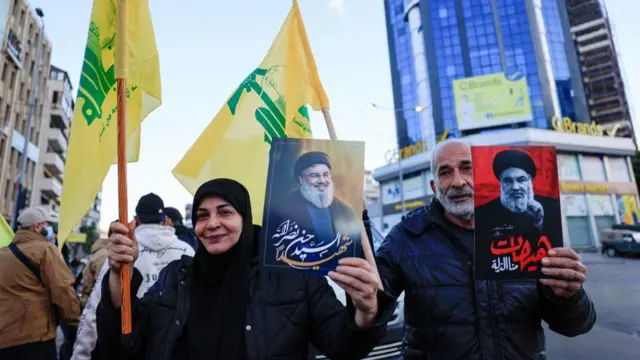 Image source, Reuters
Image source, Reuters
People carrying Hezbollah flags and posters in Beirut after the ceasefire began
It’s just gone 08:00 in Lebanon (06:00 GMT), which means the ceasefire has been ongoing for four hours now. If you’re just joining us, here is the latest:
- The ceasefire announced by the US and France on Tuesday evening went into effect at 04:00 local time. If it holds, Israeli troops will withdraw from Lebanon and Hezbollah will move north of the Litani River, about 30km (18 miles) north of the border with Israel
- US President Joe Biden says the ceasefire is designed to be permanent but Israel says it reserves the right to strike Hezbollah if it violates the agreement
- Cars carrying people displaced from southern Lebanon by Israeli strikes in recent months were seen heading south after the ceasefire began, despite IDF warnings to Lebanese civilians not to return
- The Lebanese army says it is preparing to deploy to southern Lebanon, in accordance with the ceasefire deal
- Iran, Hezbollah’s backer, has welcomed what it calls the end of Israel’s “aggression” in Lebanon
- Both sides traded fire until shortly before the deadline, with Hezbollah saying it launched drones towards Israel on Tuesday night, while Israel launched air strikes on Beirut after its military issued evacuation orders in the area
Lebanese army preparing to deploy to southpublished at 05:43 Greenwich Mean Time
The Lebanese army says in a statement that it is preparing to deploy to southern Lebanon, in accordance with the ceasefire deal.
It also asks residents not to return home until Israeli forces withdraw, Reuters news agency reports.
As a reminder, the Lebanese army is expected to deploy 5,000 troops to the south under the agreement, according to a US official – more on that here.
Syria says six killed by Israeli strikes on border crossingspublished at 05:41 Greenwich Mean Time
Four civilians and two soldiers were killed by Israeli strikes on three border crossings between Lebanon and Syria hours before the Israel-Hezbollah ceasefire came into effect, Syrian state media reports.
Twelve people were wounded, including children, women, and humanitarian workers from the Syrian Red Crescent.
The Syrian Red Crescent said earlier that one of its volunteers had been killed in the strike, which had also damaged several ambulances.
In pictures: Scenes from Lebanon hours after ceasefire beginspublished at 05:25 Greenwich Mean Time
As dawn breaks in Lebanon, people displaced by months of Israeli attacks have been pictured returning home, despite an Israeli military warning to wait until they are told it is safe to do so.
Here are the latest images from Lebanon in the hours after the ceasefire began:
 Image source, Reuters
Image source, Reuters
A man buying bread in Sidon on his way back to southern Lebanon
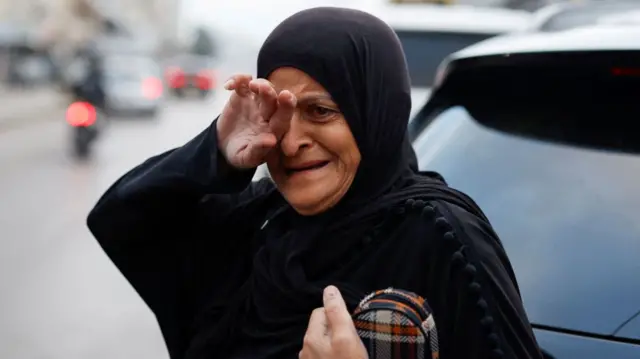 Image source, Reuters
Image source, Reuters
A woman was seen crying upon her arrival in the city of Tyre, southern Lebanon
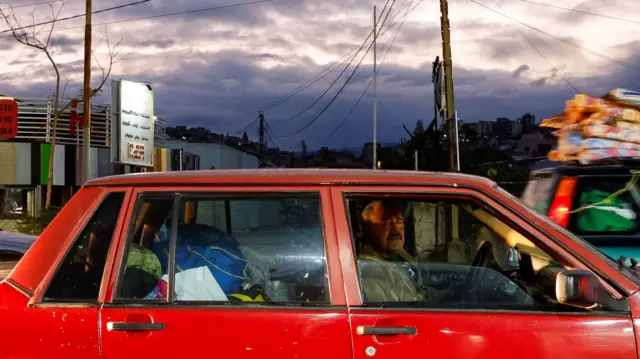 Image source, Reuters
Image source, Reuters
This man made a car journey to Sidon, southern Lebanon, despite the Israeli warning to stay put
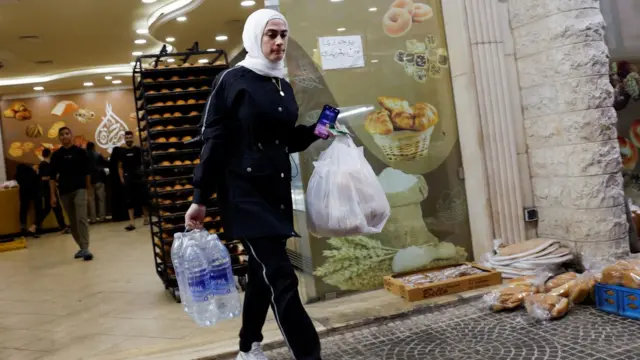 Image source, Reuters
Image source, Reuters
More people were seen buying supplies on their journeys
What we know about the Israel-Hezbollah ceasefire dealpublished at 04:47 Greenwich Mean Time
US President Joe Biden’s announcement of a ceasefire deal is set to end more than a year of fighting between Israel and Hezbollah. Here are some of the details of the deal we’ve learned from officials and media reports:
- It is meant to be a permanent deal: The deal outlines that Hezbollah and Israel will have 60 days to remove its fighters and weapons from the region and the Blue Line – the unofficial border between Lebanon and Israel – and the Litani river, about 30km (20 miles) to the north
- Lebanese troops to replace Hezbollah: The Lebanese army is expected to deploy 5,000 troops to the south under the agreement, according to a US official. But there are questions about whether the country’s military can or would confront Hezbollah forces in the area if needed
- How the ceasefire will be monitored: The US and France are joining the existing tripartite mechanism that was charged with monitoring violations of previous conflicts, which involves Unifil, Lebanon and Israel. Both Israel and Hezbollah have claimed the other violated previous ceasefire agreements
- Israel claims right to respond to violations: Prime Minister Netanyahu said that Israel would “maintain full freedom of military action” in Lebanon “with the United States’ full understanding”. Netanyahu cited moves like the group attempting to arm itself, rebuilding infrastructure or using rockets as reasons to attack
Iran welcomes end of Israeli ‘aggression’ in Lebanonpublished at 04:28 Greenwich Mean Time
Iran’s foreign ministry has welcomed what it calls the end of Israel’s “aggression” in Lebanon, according to Iranian state media.
Iranian foreign ministry spokesperson Esmaeil Baghaei reiterated Iran’s “firm support for the Lebanese government, nation and resistance”, in a statement issued after the ceasefire between Israel and the Iranian-backed Lebanese militia Hezbollah.
Earlier, Israeli Prime Minister Benjamin Netanyahu cited the “Iranian threat” as one of the main reasons for implementing the ceasefire deal, although he did not elaborate further.
Cars head towards south Lebanon as ceasefire beginspublished at 04:03 Greenwich Mean Time
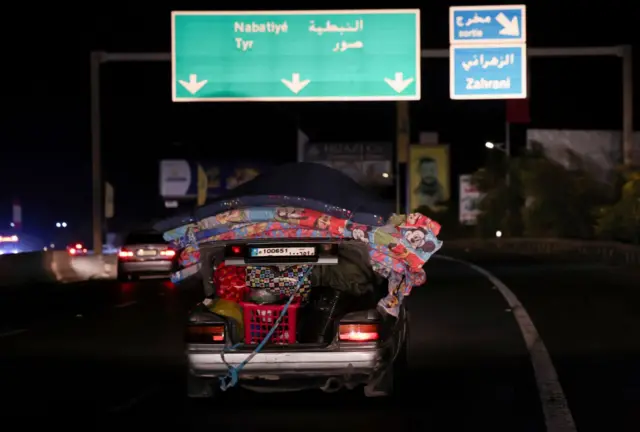 Image source, Reuters
Image source, Reuters
Cars carrying people displaced from southern Lebanon by Israeli strikes in recent months were seen heading south after the ceasefire between Israel and Hezbollah began, Reuters news agency reports.
It happened despite a warning from the Israeli military to residents in south Lebanon that it’s not safe to return home yet.
Dozens of vehicles were seen leaving the port city of Sidon, located south of Beirut, while photos taken in Zahrani show some cars stacked with mattresses and other belongings.
 Image source, Reuters
Image source, Reuters
Israeli surveillance drones flying across Lebanonpublished at 03:22 Greenwich Mean Time
Carine Torbey
BBC Arabic correspondent, in Beirut
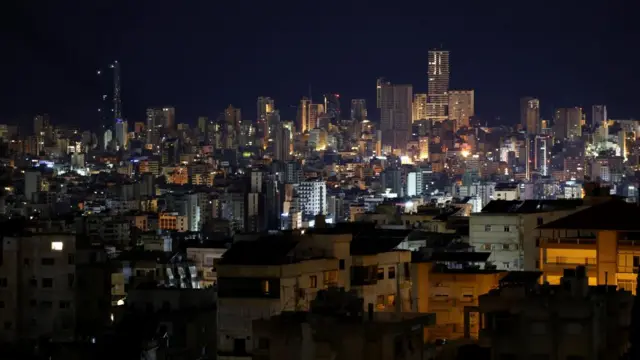 Image source, Reuters
Image source, Reuters
The scene in Beirut one hour after the ceasefire began
An hour after the ceasefire began, the distinctive buzzing of Israeli surveillance drones can still be heard in many areas in the country.
Israeli media first said that the ceasefire would start at 10:00 local time, before President Biden set the time at 04:00 in the morning (02:00 GMT).
This appeared to be one minor disagreement over the details of the implementation. Many more are expected to surface in the coming days.
For now, the persistence of the drones could be seen as another Israeli show of power about who has the last word.
That being said, there’s a concern in the country that even if the Israeli drones get out of sight, it doesn’t necessarily mean they will stop flying completely.
IDF warns south Lebanon residents not to return home yetpublished at 02:55 Greenwich Mean Time
The Israeli military (IDF) has warned residents in south Lebanon not to approach IDF positions, minutes after a ceasefire between Israel and Hezbollah began.
In a post on X, the IDF’s Arabic spokesman Avichay Adraee tells the Lebanese residents that they are “prohibited from heading towards the villages that the IDF has ordered to be evacuated or towards IDF forces in the area”.
He says the IDF remains deployed in its positions inside southern Lebanon.
“For your safety and the safety of your family members, refrain from moving to the area. We will inform you when it is safe to return home,” he adds.
